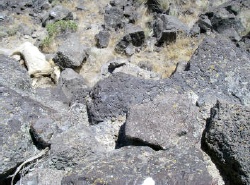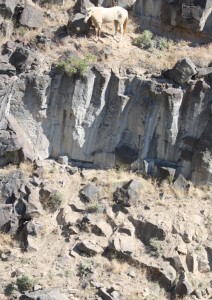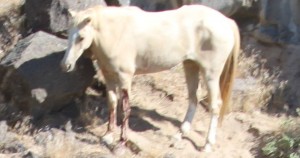By Steven Long, Photos by Katie Fite and Cattor Livestock Roundups
Exclusive from Horseback Magazine
HOUSTON, (Horseback) – A federal helicopter chase contractor has acknowledged there was plenty of water in an Elko County, Nevada wild horse area, contradicting what government lawyers told a U.S. District Judge last month.She said that many of the horses in a large herd management area just didn’t know it was there and were kept in pastures far away.
In an exclusive interview with Horseback Magazine, Sue Cattoor of Cattoor Livestock Roundups, Inc. said the Owyhee River, the border of their most recent wild horse stampede dubbed the “Tuscarora Gather,” has enough water for vacationers to camp and fish, plus multiple trails leading down to water’s edge giving access to thirsty animals including horses.
A disturbing photo of a dead Palomino Wild Horse surfaced on the Internet and in news reports last week. The picture, taken by Western Watershed Project Biodiversity Director Katie Fite shows the horse laying in rocks below a cliff. Wild horse activists say the photo demonstrates the cruelty of a government program wasting millions of dollars that is out of control. Many of them believe that a Cattoor helicopter drove the horse over a cliff.
That is not true.
But a firestorm of outrage has swept across the desert sands of Nevada and the nation at what many believe is a government agency that has turned rogue. U.S. Senator Mary Landrieu, (D) La has proposed that her colleagues consider removing the Wild Horse and Burro Program from federal Bureau of Land Management control.
And fifty-four members of Congress have petitioned Interior Secretary Ken Salazar to end the capture of wild horses on land controlled by the BLM. They have asked the National Academy of Science to investigate the agency’s Wild Horse and Burro Program. More than 150 horses and foals died in the wake of a mid-winter roundup in Nevada’s Calico Mountains. The congressmen say that 21 horses have died at BLM’s hand thus far during and after the Tuscarora stampedes.
Reno federal Judge Larry Hicks imposed a temporary injunction that had stopped the agency from capturing horses after one day in which 12 horses died after being run eight miles in more than 100 degree July Nevada desert heat. He lifted the temporary restraining order after being told by government lawyers an emergency existed because horses needed to be captured since they faced the prospect of dying of thirst because there was no water in the desert.
In fact, the BLM trucked water into the area rather than driving them, as they are clearly capable of doing, to a freely flowing river with abundant water. But she says the bulk of the horses involved in the roundup were in three pastures away from the river.
Cattoor acknowledged that the Owyhee River has running water, and during the roundup an Idaho group was camping on its banks – and even fishing.
“They were just a little ways up from where the horses trail down to the river. It‘s almost like a miniature Grand Canyon. This particular spot of where the trail goes down in the canyon is where the horses go to water,” Cattoor said.
Cattoor also said that there are other trails leading to the river that would have been available to the horses, but “the horses aren’t using those trails. They are only using this one. A lot of those horses didn’t know that trail was there because a lot of the horses we captured in this HMA were young horses.”
Typically, foals follow their mothers to water, so in all likelihood, the young horses whose habitat is near the river had been exposed to the abundant water in the waterway and the riparian area on either side, despite Cattoors comments to the contrary.
But some horses came to the river fir the first time, she acknowledges. How did these lost horses get there? Were they driven there by a Cattoor helicopter, activist are certain to ask.
“After they were down in there, they did not know how to come out,” Cattoor said.
A wide trail leads down a gently sloping river bank to the river shown in a photograph on the Cattoor website http://www.wildhorseroundups.com . Sue Cattoor says the photo is deceptive and the trail is very steep.
Cattoor says that there has been ample water in recent years to sustain horses in the area.
“I find it odd that with all the months of planning by the BLM that occurs before a round-up there was no mention of lack of water for the horses in any of their documentation and then after the lawsuit was filed, it suddenly became an emergency,” said Vicki Tobin, co-founder of the Chicago based Equine Welfare Alliance.
“The BLM has authority to round-up horses in an emergency situation so if the horses were in such dire straits, they should have dealt with the situation long before the lawsuit was filed.”
Like many in the West steeped in a ranching tradition, Sue Cattoor believes the wild horse are livestock, not wild animals. That tradition views livestock as a commodity, nothing more. Something to be bought and sold. Ranchers have a very pronounced vision of how animals should be viewed, and Cattoor is no different.
“If they are wildlife, then why don’t they issue a license for them to be hunted?” she asks.
Cattoor said campers along the river mentioned that the wild horses were in the area when they first got there, however, there were no campers around during recent visits by others to confirm what the federal contractor says.
Visitors say they found evidence that there were traps set up along the river bottom. Cattoors counters that what they believe were the remnants of BLM pens were actually the abandoned campsites of the Idaho campers who had traveled to fish the river.
There are no witnesses to refute the allegation that horses could have been driven by a roaring helicopter into the area whose rugged features include jagged rocks and towering river banks. The horses also could have injured themselves on the sharp outcrops trying to escape something they feared and had never seen before.
“They climbed up on that ledge looking for a way out and didn‘t know how to get back out of it,” Cattoor said.
In a lengthy note on the company website Sue Cattoor explains her firm’s position in minute detail. The note is also accompanied by a photo of a broad well traveled trail leading to a flowing river filled with plenty of water. Another photo of the river shows steep cliffs. Cattoor denied Horseback Magazine permission to use the photos.
Sue Cattoor acknowledges the horses were injured trying to negotiate the rough terrain.
“They were moving around in those rocks, trying to go up and down to survive and would have gotten the injury in the rocks. Those horses were trying to find a way down”
She said the pocket of possible stragglers from the helicopter chase were discovered after the helicopter pilot and her husband flew over to speak with the campers they had seen along the river.
“When they flew over to talk to these campers, they discovered these horses on the opposite side of the river from where the trail was. They herded those horses that were up there back down to the river because those horses had ledged up there and they did not know how to get back down.”
But after the herd was driven down river, the two severely injured horses remained, Cattoor said. One was the Palomino horse later photographed dead by Fite.
The photo of the still living but injured Palomino horse was taken from the Cattoor helicopter and the wound appears to be to the bone. The photo was supplied to Horseback Magazine by Sue Cattoor.
Cattoor says the horse had vision problems and was old.
“There were two horses. One, the horses that she (Fite) took the picture of, and a foal that was caught in the crevasse of the rocks with broken legs that they had to go back and euthanize,” Cattoor said.
Former Horseback Magazine veterinary columnist Dr. Angela Chenault viewed the blown up photo and said the injury was possibly survivable, but “its not likely to have a good outcome on a feral horse. Aftercare is critical and even stalling this horse will be a problem mentally.”
The horse found by Fite was not driven over the cliff to its death by Dave Cattoor, it was shot by him from the helicopter with a high powered rifle.
“It happens on occasion because when we are out gathering horses, if we see something that has a pre-existing injury or if something is extremely old and needs to be put down, they will euthanize it in the field,” Cattoor said.
Dr. Chenault said the injury was not fresh.
“It’s difficult to say how old by the picture but I would say it is over 24 hours by the way the muscles look,” she said.
Activists will likely continue to believe the worst of the Cattoors and their company. And Sue Cattoor will continue to attempt to spin the image of a company that is compassionately capturing horses, even if some die in the process.
The helicopter contractor said that despite the judge’s ruling that observers be allowed to view the roundups, her company will not allow observers on horseback despite a long standing Horseback Magazine request to the BLM to do so.
“If they are on horseback they are going to interfere with the operation,” she said. “We never allow our wranglers to be on horseback when the helicopter is driving horses to the trap. We can’t have somebody there that might turn the horses back and cause problems.”
Cattoor said she would have no objection to observers who hiked in to the roundup area if they were accompanied by a BLM public relations person. In past “gathers” armed guards have prevented observers and the press from freely walking into the roundup area.
Despite encouragement from Cattoor for Horseback to observe a roundup, BLM has barred press and public in the trap area because recent ones have been located on private property. The agency claims landowners object to media and other observers on their land. However, when the BLM leases property for a site, it falls under federal control much like a post office building does when it is leased by the federal General Services Administration for public use. The landowner relinquishes control of his property to the control of the federal government.
Cattoor Livestock Roundups will not allow the media to fly as passengers in their helicopter citing prohibitions from their insurance company.
“I have no problem with the press coming out and watching if they want to, as long as they are absolutely not interfering with the gather and causing stress for the horses,” she said.
Cattoor also was critical during the interview of media reports of the numbers of horses which died “because of helicopter gathers.”
On the Calico roundup seven horses died in the field out of a total of more than 150 horses and unborn foals who met their deaths in captivity, including two foals who shed their hooves after being stampeded over rocky terrain in the dead of winter by a roaring helicopter.
“In this roundup we didn’t lose any on the actual HMA (herd management area). Others died for lack of water or too much water, or were destroyed for humane reasons,” Cattoor said.
“They are trying to stop roundups saying the helicopter gathers are cruel and inhumane and that’s not a fact,” she said. “The losses from Calico was because those horses were in very bad shape when they were captured because there wasn’t enough food out there.”
Photographs of the captured Calico horses by naturalist Craig Downer and wild horse litigant Laura Leigh show fat healthy horses even in the BLM hospital area.
And 54 members of Congress clearly want to knock Sue Cattoor and her company out of a job, temporarily at least.
And litigation continues in the courts to stop what the BLM benignly calls “gathers.”
_______________________________
_______________________________












No comments:
Post a Comment